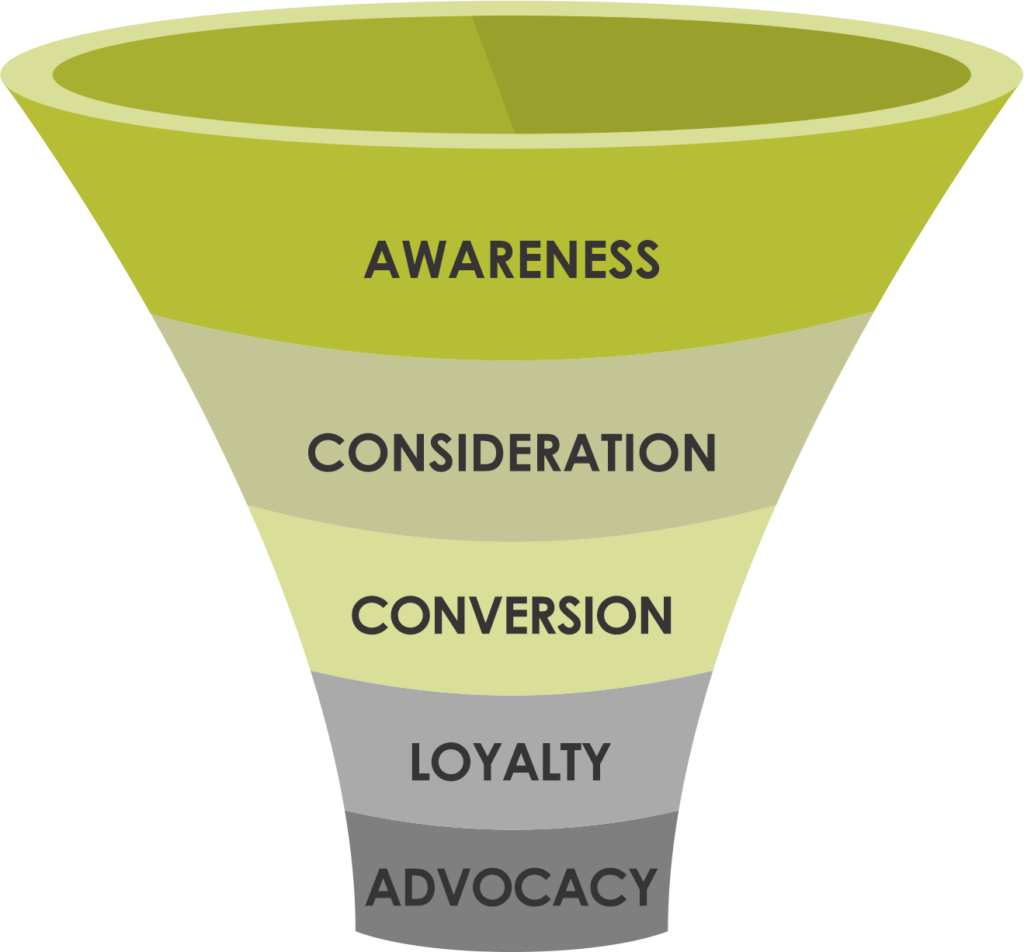Raise your hand if you’ve ever heard of a marketing funnel. Don’t worry if you haven’t, we aren’t taking notes.
However, if you’ve ever talked to a marketer about strategy, read marketing blogs or taken a marketing course in school, chances are you’ve heard the term thrown around.
The marketing funnel, also known as the sales funnel or customer journey, is a model marketers use to showcase the stages a customer goes through on the path to making a purchase. Basically, it’s a visual representation of that process.
What is a marketing funnel?

Understanding the technical definition is only a piece of the marketing funnel puzzle. It’s important for marketers to not only be able to clearly define the meaning, but also explain how and why each piece of the marketing funnel fits into a marketing strategy.
Marketing funnels outline the stages a customer goes through in the process of becoming a customer, including awareness, interest, desire and action.
No campaign should launch without a strategy, and every strategy should be based on a marketing funnel. Developing a campaign strategy using a marketing funnel helps us develop effective marketing roadmaps and sales processes. These target specific stages of the customer journey.
By breaking down the customer journey into smaller stages, we can develop more targeted messaging and tactics that speak to the needs and motivations of your customers. First, we’ll start at the widest part of the funnel – awareness of a product or service.
Top of funnel (aka brand awareness)
The first stage of the marketing funnel is brand awareness. This is the point where customers become aware of your product or service. They may have a problem or need that your product or service can solve. Or, they may simply be browsing online or driving across the highway and come across your brand.
Marketing tactics used in the awareness stage include digital marketing, content marketing, billboards and advertising, such as TV commercials. The goal of these tactics is to attract potential customers and create brand awareness.
Building interest and fostering relationships
Once a customer becomes aware of your product or service, they move to the consideration stage. At this point, they are interested in (or…considering) learning more about your product or service and how it can help them solve their problem or meet their needs.
Marketing tactics used in the consideration stage include emails and newsletters, webinars, case studies and other types of downloadable content. The goal of these tactics is to build trust and provide social proof that your product or service is the best choice.
What’s the goal? To provide more information and build a relationship with the potential customer through eye-catching and engaging content. This increases both discoverability and awareness.
Have you ever had a friend ask if you’ve seen a commercial or advertisement? Customers are more likely to share products and services with another person if the advertising content is memorable.
Customers in this stage are now evaluating different options and deciding whether your product or service is the right choice for them.
Lights.. Camera.. Action!
Then, we spiral deeper to the conversion or action stage. This stage is exciting because it’s measurable, plus you get to reap the rewards of all your hard work from the previous steps! Typically, the conversion stage is where the potential customer makes a purchase and officially becomes a customer.
Marketing tactics used in the action stage include special offers, promotions and discounts. The goal of these tactics is to encourage the customer to take action and make a purchase.
While we can get caught up in sales, purchases and the bottom line, it’s important to remember that a customer can’t make a purchase without knowing your brand exists.
Loyalty and advocacy
Finally, we find ourselves at the most coveted levels of the funnel – loyalty and advocacy. Your brand’s success depends on trust. In our current economic downturn, people are being more selective with how and where they spend their money. Customers will be more likely to recommend your product or service to others once they realize you’re reliable. This can grow your brand exponentially. If your brand isn’t deemed trustworthy, you are more likely to lose customer loyalty and stunt company growth.
A loyalty program is a type of advocacy tactic where your customers can help support your marketing funnel strategy. These types of programs and tactics can consist of referral discounts, customer testimonials, reviews and social sharing.
However, customers may need to be incentivized to participate. Not only does it need to be easy and fun, you may need to offer additional value. This can come in the form of discounts, freebies, upgrades, personalized thank-you notes or access to exclusive content.
Full-funnel marketing measurement
Lastly, you don’t want to build a beautiful customer journey through your marketing funnel… and then never keep track of it. It’s important to analyze how your target audience is moving through your marketing funnel.
Are you seeing a lot of interaction for your brand awareness campaigns, but then a drop-off in conversions? Are people signing up for a newsletter, but no one’s making purchases?
Overall, marketing funnels are a useful tool that helps businesses understand and track the behavior of their target audience. By developing targeted marketing strategies and sales processes that address specific stages of the customer journey, businesses can track how customers move through and improve their chances of converting potential customers into loyal customers.
